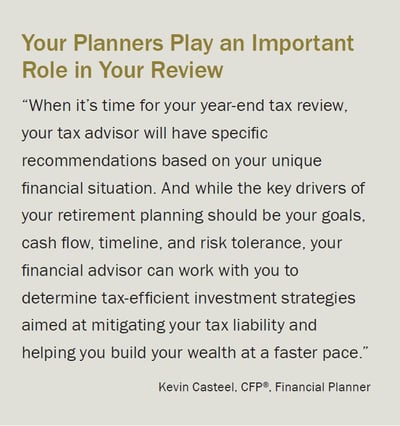4 min read
Tax Planning: Key Strategies for Your Year-end Tax Review
 Kevin Casteel, CFP® Trust Officer, Financial Planner
:
Oct 26, 2023 3:05:00 PM
Kevin Casteel, CFP® Trust Officer, Financial Planner
:
Oct 26, 2023 3:05:00 PM

It’s a fact of life: We have to pay taxes on our income. And no one — regardless of how much money we have — enjoys paying the IRS. That’s the primary reason we’re constantly searching for opportunities and financial strategies to help us manage, defer, and reduce our tax liabilities.
One such opportunity rolls around at the end of each calendar year when many individuals take inventory of the strategies they’ve used to reduce their tax bill: the year-end tax review.
Here are a few tips to help you get the most out of this annual process.
Check where you stand with contributions to retirement and education savings/investment accounts.
- Have you reached the annual maximum contribution amount (or your desired contribution amount) in your 401(k), 403(b), IRA, Roth IRA, and other retirement accounts? Your contribution strategy helps defer income to your retirement years when you may have less income, resulting in a lower tax obligation.
- 529 plans are savings accounts operated by most states and are designed to help families save for college. While contributions to these plans are not deductible on your federal taxes, many states offer tax deductions for contributing to qualified 529 plans up to a certain dollar limit. The earnings on your contributions grow tax-free.
Make sure you have satisfied any required minimum distribution (RMD) amounts by year’s end.
- Once you retire and reach a certain age, you must start making withdrawals from your retirement accounts. If you have inherited an IRA, make sure you are meeting RMDs for these accounts as well.
Note: Secure 2.0 also impacted the age requirements for making withdrawals from retirement accounts. Beginning RMD ages now range from 72 to 75 years, depending on the current age of the account owner. - RMD amounts are calculated using the prior year’s ending balance in a retirement account and a factor provided by the IRS. The required withdrawal percentage increases year-over-year.
- You may want to consider using these funds to cover tax liabilities, satisfy withholding requirements, or meet charitable goals through qualified charitable distributions (QCDs).

Review the status and balances of your flex spending accounts (FSAs) and health savings accounts (HSAs).
- You can make contributions to FSAs without paying Social Security and income taxes on those amounts. However, they are of the “use it or lose it” variety unless the plan allows for a carry over. It’s important to have a plan to exhaust or reduce the balance to the allowed carry over by the end of the year, otherwise the funds will be forfeited.
- Make sure you have funded HSAs to maximum or desired levels to achieve triple tax-exempt status (if used for qualified medical expenses):
-Your contributions to the account are deductible.
-The funds in your account grow tax-deferred.
-When you remove funds for qualified medical expenses, the withdrawals are tax-free.
Gather information to calculate tax deductions.
- Charitable contributions, education savings, state/local taxes, medical expenses, and mortgage interest are the most common.
- Compare the totals to the standard deduction to decide if itemizing is beneficial.
Consider the impact of gains and losses.
- Harvesting losses can help offset any gains realized during the tax year, reducing capital gains taxes owed.
- Mutual funds generally pass capital gains on to investors in the fourth quarter. Depending on balances in different funds, taxes due could disrupt expected cash flow.
Enlist your financial professional to monitor these holdings and opportunities for tax savings.
Gather documentation and records of your charitable giving.
- Consider charitable gifts of appreciated securities. You as the donor earn a charitable deduction and won’t pay capital gains taxes on transfer of the asset. The charity receives full benefit of the gift.
- If you have reached the age of 70½ years, you could gift up to $100,000 directly from your IRA through QCDs. This satisfies RMD requirements and reduces your adjusted gross income (AGI).
Consider gifting to family members to reduce future estate taxes.
For 2023, gifts of up to $17,000 each ($34,000 for you and your spouse combined) can be given to multiple individuals without tax consequences. The current lifetime exemption of roughly $13 million per individual is set to reduce by approximately half in 2026.
Consult your professional advisors.
This is not an exhaustive list by any means, and your tax advisor will have specific recommendations based on your unique financial situation. While the key drivers of your investment planning should be your goals, timeline, and risk tolerance, you should work with your financial professionals to consider tax-efficient investment strategies that factor in your tax liability and may help you build your wealth at a faster pace.
We can help
When it comes to timing tax strategies, you will find that some investments are more tax-efficient than others. The tax laws are numerous and complicated — it’s important to seek the advice of your professional advisors to help you determine which vehicles are the most appropriate and advantageous for your financial planning goals. Contact Commerce Trust today — we’re here to answer your questions and help you make informed decisions.
Certified Financial Planner Board of Standards, Inc. (CFP Board) owns the certification marks CFP® and CERTIFIED FINANCIAL PLANNER™ in the United States, which it authorizes use of by individuals who successfully complete CFP Board’s initial and ongoing certification requirements.
The opinions and other information in the commentary are provided as of October 26, 2023. This summary is intended to provide general information only, and may be of value to the reader and audience.
This material is not a recommendation of any particular investment or insurance strategy, is not based on any particular financial situation or need, and is not intended to replace the advice of a qualified tax advisor or investment professional. While Commerce may provide information or express opinions from time to time, such information or opinions are subject to change, are not offered as professional tax, insurance or legal advice, and may not be relied on as such.
Commerce Trust does not provide advice relating to rolling over retirement accounts.
Data contained herein from third-party providers is obtained from what are considered reliable sources. However, its accuracy, completeness or reliability cannot be guaranteed.
Commerce Trust is a division of Commerce Bank.
Investment Products: Not FDIC Insured / May Lose Value / No Bank Guarantee
Interested in more insights?
Subscribe Now.
Related Articles
